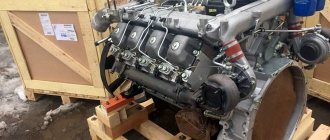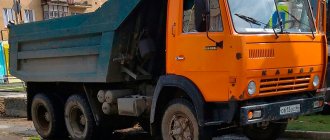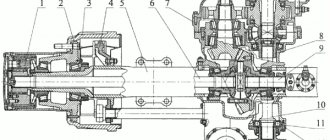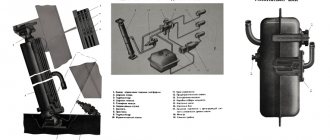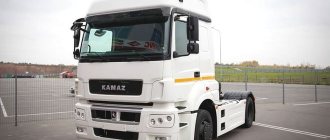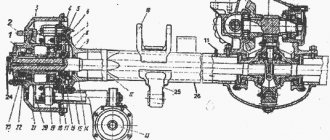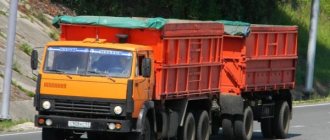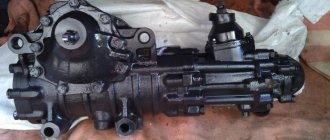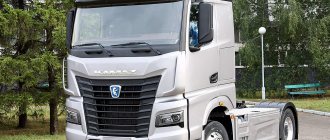In the automotive world, there is still no better way to test new technologies and test design solutions than motorsports. From rallying, Formula 1 and touring car championships, compressors and turbines, direct injection and energy recovery systems came under the hoods of civilian cars, and from there, ordinary drivers got countless electronic assistants. But if for manufacturers of passenger cars the presence of racing teams is natural and understandable, then in the world of freight transport everything is not so obvious.
Kamaz was lucky - it caught the motorsport “virus” from its Volga counterpart, Avtovaz. Mikhail Godzinskoy, transferred from Tolyatti to Naberezhnye Chelny by the decision of the minister to the position of director of an automobile assembly plant, organized an ice racing section there, similar to the one in Tolyatti. It became very popular, and it soon grew into the annual “Inter-Director” ice rally in passenger cars - essentially a team building event for directors of USSR automobile factories and their foreign partners.
The rally was attended, as they would say today, by top managers from all over the country, as well as suppliers of parts from Europe. The level of Chelny motorsport fans is evidenced by the fact that when a buggy section was also opened at the plant, five of its members soon joined the national team, and when the summer rally “Director” was organized in Moscow, by analogy with the “Inter-Director”, it the first winner was the head of the Scientific and Technical Institute Semyon Yakubov, the future leader of the Kamaz-Master team and the navigator of Vladimir Chagin’s crew.
Advertising on Forbes
In January 2022, the Kamaz-Master team won its 15th victory in the truck category of the Dakar Rally·DR
“Truck sport already existed then, and we had a cross-country team at the plant,” recalls Yakubov, “but after one of the members of the Central Committee criticized in the newspaper, saying that trucks should carry cargo, and not chase each other, this direction was covered, and then these trucks stood for a long time in the corner of the yard of the car assembly plant. Then there was an attempt to compete in circuit racing. Painted trucks, girls in swimsuits - everything encouraged participation, and we prepared two cars, but we couldn’t get higher than fifth place. You know, our automobile industry was not the best in the world. I understand that I did not discover America for you, but we felt it ourselves: our engines were weak, we had not yet heard about electronics, everyone had injectors, but we had carburetors, we didn’t even install disc brakes on passenger cars... There was competition hard. And although we won prizes, it was only the audience award; everyone saw how we fought. We skidded through the turns, bypassing our rivals, but on the straights we still fell behind... And then I learned about the Dakar.
Alas, the legend was not able to get to the race right away. Tragedy occurred at the 1988 Dakar: a unique DAF Turbo Twin truck with two engines, each driving a separate axle, was involved in an accident in which the navigator died. That DAF once raced up to 200 km/h during the race and easily overtook both trucks and cars, but the tragedy forced the organizers to introduce restrictions: only production models could now participate in the truck class. So the first international starts of the Kamaz-4310 rally took place at the Jelch rally and the Objective Sud rally, at each of which Soviet trucks took second and third places. In 1990, trucks were allowed to participate in the Dakar with certain restrictions.
"Kamaz-Master" 4326
Classic supercars are capable of striking only on ideal roads, but the Russian supercar from the Blue Armada is ready to fly without disassembling the road. Deserts and rocks, swamps and snow fields - all this is his natural habitat. These are the technologies that provide the Kamaz-Master truck with superiority on any surface.
Engine
16-liter V8 Liebherr D9508, 950 hp. With. with a torque of 4500 Nm. At first, combat vehicles used 305-horsepower 11-liter V8 Kamaz-7403, but in the fire that destroyed the engine plant, the Dakar combat units undergoing training there were also killed, so the team had to temporarily switch to 14-liter 520-horsepower Cummins N14- 500E, after which the almost 20-year era of engines from the Yaroslavl and Tutaevsky Motor Plants began - YaMZ and TMZ 7E846/7/8, with a volume of 18 liters and a power of 850 hp. With. and with a torque of 2700 Nm (modifications of these engines can be found on Belaz mining dump trucks, river tugs and locomotives). Heavy and voracious, but indestructible and omnivorous, they easily coped with any fuel and were replaced only after the introduction of volume restrictions at the Dakar. They were replaced by a 13-liter Cummins ISZ-13 and a 16-liter Liebherr D9508, with 920 and 980 hp. With. respectively. Kamaz-Master purchases serial engines, after which it boosts and rebuilds the engines in its Scientific and Technical Center. The scale of the improvements is indicated by the fact that after them the power approximately doubles.
D.R.
Weight
10.2 tons. For comparison: the first truck weighed 10.5 tons, and in the history of the team there was also a 12-ton monster. To make the car lighter, they use all sorts of tricks - for example, cutting off the bolts that secure the wheels. The minimum weight allowed under the regulations is 8.5 tons.
Cabin
Changing the cockpit during the race is prohibited, but changing the engine, axles, transmission and other key parts is possible. During the truck design stage, the size and location of the cab depends on the engine chosen. In the near future, the place of the German engine will be taken by Kamaz, which is now undergoing final tests.
Radiator
January in South America is hotter than in Africa. Therefore, the cooling system was redone, because the speed of the car depends on the oil temperature.
Speed
Maximum speed is 165 km/h, acceleration to 100 km/h in 9.8 seconds.
Transmission
16-speed ZF.
Advertising on Forbes
D.R.
Approach angle
Officially, the maximum is 60°, but the pilots assure that a steeper climb can be taken while moving.
Fan
Despite the heat (40–45 °C), there is no air conditioning in the cabin - it would not withstand the shaking, would increase the weight of the car and take away some of the power from the engine. Three fans with rubber blades are responsible for cooling (to prevent them from breaking and causing injury). The temperature in the cabin during the race reaches 55 °C, while the pilots are dressed in fireproof suits. You can’t drink a lot of water so that you don’t have to stop later. “It’s impossible to eat on the go - everything will jump around the cabin, and then in the stomach,” says Vladimir Chagin, head of the Kamaz-Master team and seven-time winner of the Dakar Rally. “We drink two sips, no more.”
Fuel tank
Advertising on Forbes
A 1000 liter tank is mounted above the rear axle to counterbalance the engine that loads the front axle.
Tires
Continental HCS 14R20 tires participate in the suspension; the pressure in them can be changed in the range from 2 to 7 atmospheres directly from the cab. There are breakdowns at the race every day, and during a rally raid each truck uses up to 18 tires; in total, the team changes from 300 to 320 tires during the season.
Suspension
Reiger Racing sports struts with adjustable stiffness at one time replaced the shock absorbers from the BMD (landing combat vehicle). The design of the struts was modified by the manufacturer in accordance with the requirements of KAMAZ workers, who after the races saw the potential for improving parts and proposed a design solution.
Advertising on Forbes
Devices
In addition to the usual instruments in the cockpit, each crew member has his own equipment. The navigator has GPS and Terra Trip, which provide accurate data about the location of the car. The mechanic has 24 temperature sensors of different components, which show where overheating begins, which usually precedes a breakdown. The pilot has speed control lamps above the windshield. The speed on the Dakar is limited to 140 km/h; when approaching this indicator, the lamps light up one by one - this means that you cannot accelerate any further. In addition, there is a device in front of the driver that informs that a faster car is approaching from behind, which, according to the rules, must be allowed to pass. In 1997, the signal from this sensor was ignored by the pilot of a jeep walking in front of the car of Chagin, Yakubov and Savostin; in the dust, the Kamaz-Master team did not see the turn and the car overturned four times, which almost cost the crew their lives.
Why the hood?
At first glance, the hood layout of the truck seems outdated. This can be said if you do not take into account the conditions in which you plan to operate the car. The fact is that the front engine location has its certain advantages. Since the cabin is stationary and not tilting, this opens up the possibility of mounting various special add-ons, such as drilling equipment or repair equipment, on the existing chassis.
The presence of a hood is especially important for northern regions, since in frosty weather there is no need to lift the entire cabin to gain access to the engine. In addition, the designers developing the KamAZ-4355 tried to make access to the power unit as easy as possible by making the hood a single part without sidewalls. It is also worth noting that the hood itself is made of lightweight but durable plastic.
The stationary nature of the cabin also makes it possible to significantly simplify the task of additional insulation of the cabin. In addition, the hooded KamAZ-4355 is equipped with an autonomous heater with adjustable air supply, which can operate even when the engine is turned off.
For personal use
DR
Sports Kamaz can be ordered at the plant in Naberezhnye Chelny. A new truck will be built in 9 months (the team produces 2-3 vehicles per year and sells one), or you can reserve one of the team’s vehicles and buy it back after it is written off. In this case, it is possible to get, for example, a truck that won the Dakar. In both cases, the truck can be legally used on public roads. While waiting for a car or after purchasing it, you can take a driving course with the Kamaz-Master team.
The price of a combat Kamaz is €600,000–800,000.
“You can hardly feel the speed in the truck, and you need to get used to it, besides, the capabilities of the vehicle are usually higher than the capabilities of the pilot, and you need to learn to feel the line beyond which it is better not to cross,” advises the head of Kamaz-Master, Vladimir Chagin. Among the buyers of Kamaz trucks there are even Arab sheikhs, for whom the desert for full-fledged off-road trips is literally at arm's length.
- Drown €1,000,000 in mud: rally raids are one of the most expensive sports
Reasons for the appearance of the “nosed” KamAZ
According to the plant management, which was expressed to representatives of the press, the production of a truck of this type will help expand the existing family of all-wheel drive heavy trucks capable of successfully solving problems in the most inaccessible areas of the North and Siberia. In addition, KamAZ-4355 will be useful to oil and gas workers, rescue workers and the army, in forestry and will take its rightful place in these industries among the already proven URALs and MAZs. From the above, it becomes clear that, in fact, KamAZ decided to try to develop a new field of activity, to find and occupy its niche, squeezing out competitors.
KamAZ-4355: technical characteristics
To create a bonneted KamAZ, the aggregate base of model 43118 was used.
- The wheel formula of the car is 6x6.
- With a total weight of 20,190 kg, the load capacity of the “bonnet” is 10,500 kg.
- The gearbox has ten shift stages, and the transition from gear to gear is carried out by a special joystick that works according to the same algorithm as a traditional floor lever. The transmission is engaged using an electric pulse sent from the joystick to the actuating pneumatic cylinder.
- The clutch consists of two discs and is of the diaphragm type. Equipped with a hydraulic drive with pneumatic reinforcement.
- Disc-type wheels with pneumatic tires size 425/85 and a radius of 21 inches with the ability to adjust the pressure.
- KamAZ-4355 is capable of reaching a speed of 90 km/h.
- The maximum steepness of the climb angle is at least 30%.
- Turning radius (external) - 13.4 meters.
- Fuel capacity - 350 l (main tank) and 210 l - additional.
Catalog of spare parts for KamAZ-43118 (43118):
Our catalog contains all spare parts used in KamAZ-43118.
Select the node you need. To make it easier to find spare parts for KamAZ-43118, you can use the quick filter. Quick Filter by nodes:
- Body
BodyInstallation of cockpit with empennage
- Cabin with painted doors
- Front mount and cab balancing mechanism
- Installing insert nuts on the cabin
- Installing rear cab suspension
- Upper bracket
- Cab spring
- Installation of the cylinder and pipelines of the cabin tilting mechanism and the spare wheel brake control
- Installation of the cylinder and piping of the cab tilting mechanism
- Installing the cab lift limiter
- Spare wheel lift cylinder
- MOK cylinder
- Cylinder
- Cabin tilt pump
- Right cab lock
- Left cab lock
- Cabin lock bracket, right
- Windshield wiper installation
- Installation of the instrument panel
- Installing a roof vent
- Installation of glass and door fittings, right
- Seat installation
- Heating system installation
- Installing seat belts
- Installation of cockpit empennage
- Platform
- Engine
Engine
Power unit 7403.10, complete for installation on a vehicle
- Power unit KamAZ-7403.10
- Engine with equipment
- Installation of the power unit
- Installation of oil radiators
- Front support bracket
- Rear power unit support shoe
- Cylinder block
- Cylinder block
- Front block cover
- Flywheel housing installation
- Flywheel housing
- Gas distribution mechanism
- Cylinder head
- Cylinder head
- Piston with connecting rod and rings
- connecting rod
- Installing the power take-off half
- Installing the crankshaft
- Crankshaft
- Gear
- Installing the flywheel and retainer
- Flywheel
- Flywheel
- Flywheel retainer
- Camshaft
- Bearing shell
- Rocker post
- Valve rocker arm
- Gas pipeline installation
- Installing the oil sump
- Oil level indicator guide tube with ring
- Oil level indicator with seal
- Oil pump installation
- Oil pump with gear
- Oil pump suction pipe
- Oil filter
- Tap
- Stopcock needle
- Tap plug
- Installing the crankcase ventilation tube
- Installation of a ventilation system
- Breather pipe with bushing
- Breather elbow
- Centrifugal oil filter
- Installing the Solenoid Valve and Pin Glow Plugs on the Engine
- Front bearing housing
- Installation of pre-heater PZD-30
- Installation of pumping unit
- Pre-heater fuel pump
- Pump unit supercharger
- Boiler heater
- Mounting the boiler heater
- Fastening the heater fuel tank
- Drive coupling half of the fuel pump drive
- Installation of the exhaust system
- Radiator installation
- Clutch
Installing the pedal and release drive
- Gearbox with divider, control and clutch parts
- Installing the transfer case
- Installation of cardan shafts
- Front axle
- Rear axle
- Bridge average
- Frame, bumpers and engine mudguards
Installing the front buffer
- Front suspension installation
- Wheel installation
- Steering control
Installation of the steering mechanism
- Installation of air brakes
- Electrical equipment
Electrical equipment. Location by car
- Dashboard
- Power take-off
Power take-off
- Winch installation
Spare parts diagrams and components are presented on the website for reference purposes! We do not sell all spare parts for KamAZ-43118 presented in this list, but many of them.

